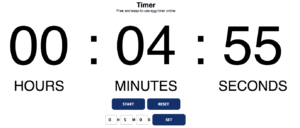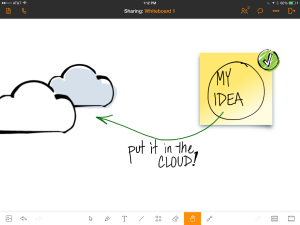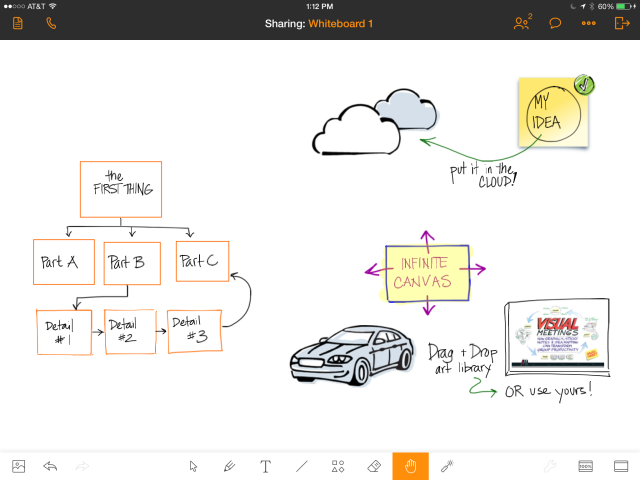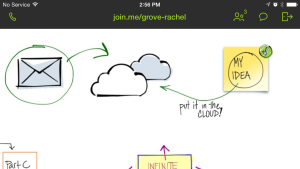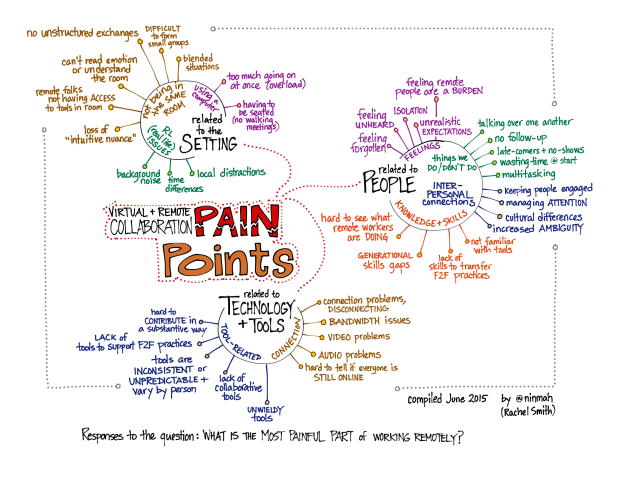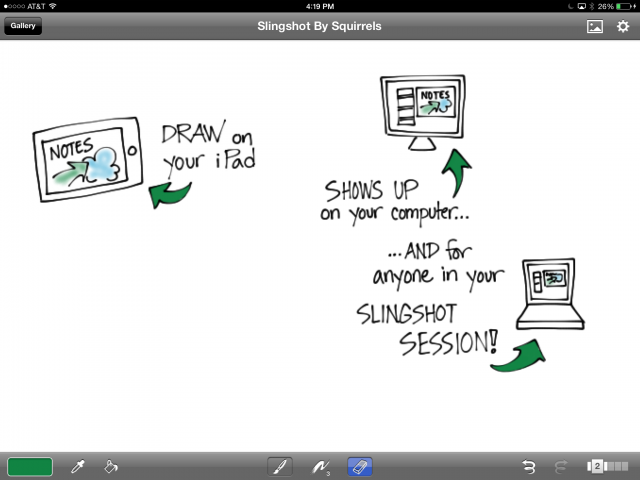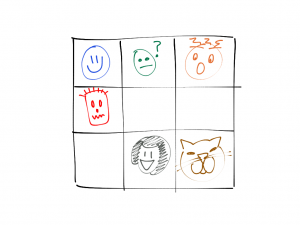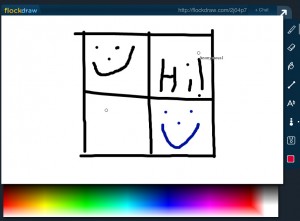Last week I had the marvelous opportunity to chat with Rachel Hatch, one of the research directors for Institute for the Future (IFTF)’s Ten-Year Forecast program. Rachel is into a wide range of fascinating things including affective technologies, which are devices and systems that can detect, interpret, and/or represent human emotions and behaviors related to emotions. She also has a radical view about virtual meetings: what if we don’t try to make them as good as face-to-face meetings? What if we look at them as something totally different and make them the best that they can be, in ways that don’t map to face-to-face meetings at all? Mmm. Love it.
I’m really curious what YOU think about some of the ideas we talked about. Each of the sections below ends with a question. If you have thoughts about one or more of them, post your answer in the comments.
Attentional Proximity
Our conversation started with the idea of attentional proximity, which is people paying attention to the same thing at the same time. Rachel observes that in collaborative work, attentional proximity is more important than physical proximity (i.e., being physically near someone). She also notes that physical proximity doesn’t guarantee attentional proximity; just think of the last time you tried talking to someone next to you who was busy playing with their mobile, and you’ve got the picture of physical proximity without attentional proximity.
We talked about how challenging it is to convey attentional proximity in remote settings. The cues that we are used to depending on, like body language, gaze direction, and posture, are often unavailable in those settings. Rachel also pointed out that among colleagues she feels in tune with, she finds it easy to share attentional proximity even at a distance, and she raised the question of what might be at the core of those interactions that makes them flow so well and be so productive.
I’ve experienced this too—there are some people it just seems easy to be in sync with, or some situations where it has just clicked—and I also wonder what makes that happen or not happen. Obviously if one of us is distracted or thinking of something else, we won’t get that ‘click,’ but sometimes it just doesn’t seem to happen no matter what.
Question 1: Have you experienced attentional proximity with someone at a distance? How did you recognize it, and what do you think allowed that to happen?
Copresence
Last fall, Rachel wrote an article, From Telepresence to Copresence, about shifting the conversation around remote work from aiming for telepresence (“as if you were there”) to embodying copresence (“different from and maybe better than being there”). This is an idea that I really love as a way to reframe virtual work. She points out that using the term ‘remote’ or the prefix ‘tele’ puts distance at the center of the relationship. ‘Copresence,’ on the other hand, puts togetherness at the center.
As near as we can tell, the term copresence comes from sociology, where it describes the experience of being with other humans, either physically or otherwise (see this article by Shanyang Zhao at Temple University for a taxonomy of types of copresence). I asked Rachel to describe what copresence looks like with a geographically dispersed group or team; how can you tell when you’re experiencing it? She responded that what it brings to mind for her is having an ambient sense of who is available for shared attentional proximity, and when. She’s thinking of signals like we might see with Skype icons (available, busy, offline, grumpy, what have you), but “embedded in the surfaces of the environment in subtle ways that impact your actual experience of the space as a remote worker.”
She also sees a trend toward micro-collaboration, where people work together for very short periods of time and need to be able to shift in and out of collaborative relationships quickly and easily. This implies a need for indicators of trust (as in, how much of the company’s IP is this person trusted with) that could be supplied by some of the same technologies that deal with attentional proximity and ambient prompting.
Question 2: What do you think about the term copresence? Do you find that it opens possibilities for how we think about working together at a distance, or do you have a different view?
Reframing Virtual Meetings
I was struck by Rachel’s idea about reframing virtual meetings partly because of a response that came in to The Grove’s Five Minutes on Working Virtually survey last May. One of the respondents expressed the view that virtual meetings can’t be improved, and it got me thinking. Attempting to recreate face-to-face meetings in virtual settings isn’t a long-term strategy, I have to agree. While high-end video conferencing is a great option, I don’t think it’s the right solution for most people because I really feel that it should be possible to fully participate in virtual meetings right from your own desk. Virtual reality and holograms may eventually provide options for avatars that are even better than ‘being there,’ but right now, they just don’t.
I think we are still working on this, and I see two big groups of technologies that will help virtual meetings come into their own: hardware-based tools and software-based tools. The hardware-based tools take advantage of affective technologies by giving us physical objects that convey some of the cues we would normally get in other ways, like the ambient collaborative prompts Rachel mentions in her article, or wearable devices that signal the user with vibrations or other sensory information.
The software-based tools don’t require any additional objects and include programs or apps that support activities that can be done online as well as or better than they can be done in person. These include tools for using sticky notes card boards, collaborative drawing, polling and voting, and the like. Right now, most of them are aiming for the ‘as well as’ category by reproducing activities that would be done in a face-to-face meeting, maybe adding a few extra features, but not really breaking totally new ground. I think there’s a lot of room for really new ideas about what we can do online to support collaborative work that is simply different from what can be done in person.
Question 3: What do you think? What would you love to do in a virtual meeting that would support your work, but can’t be done face to face?
Rachel’s Seven Shifts
Rachel’s article, From Telepresence to Copresence, concludes with a list of seven shifts we should make if we want copresence to be the norm in 2025. I asked her which of the shifts she thought would be easiest to make, and which the hardest; and I asked her to say which one she felt would have the greatest impact. Here are her thoughts:
RS: Which shift will be the hardest?
RH: The first [“as if” you were there to better than if you were there] or last [pre-structured days to emergent, just-in-time calendaring] would be hardest. The calendaring thing is so deeply embedded, how we relate to time is so deeply embedded, it’s the substrate of everything. This one will be the most challenging in traditional business contexts.
RS: Which will be easiest, in your view?
RH: Ambient signals of availability might come on line pretty quickly because of the pace of change around the internet of things and networked smart objects. We’ve seen a lot of Kickstarter campaigns for things like the TapTap bracelet and so on, and I think social norms will come along quickly. It’s an intermediate step; once you see these things everywhere, you start to ignore them after a while. Where it gets interesting is if the design of the experience can convey an energy; a spectrum, a different set of colors, something so we know how you’re feeling and not just whether you’re there.
RS: If we could universally, magically, make just one of those shifts right now, which one would be the most impactful?
RH: Shifting from physical to attentional proximity. It would unleash so much productivity! Imagine ‘just-in-time dream teams,’ where you can capture someone’s attention just at the right moment of a project based on their location… You could grab their attention for half an hour, take advantage of those efficiencies and just in time interactions.
Question 4: Looking at the seven shifts in Rachel’s article, which one grabs you? Why?
Like this:
Like Loading...



